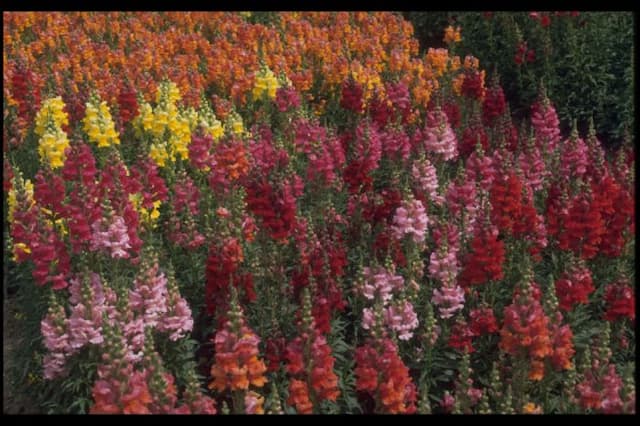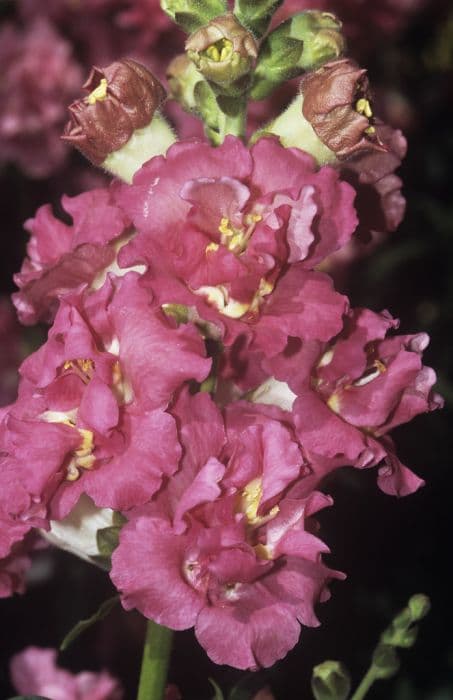Scouler's penstemon Penstemon fruticosus var. scouleri
ABOUT
Penstemon fruticosus var. scouleri, commonly known as Scouler's penstemon, showcases a captivating and ornamental appearance. The plant boasts a base of evergreen foliage consisting of shiny, narrow leaves that maintain a vibrant green hue throughout the year. As the seasons advance, the foliage serves as an attractive backdrop to the standout feature of Scouler's penstemon – its flowers. The blooms are prominent, tubular structures that delicately showcase a gradient of colors ranging from deep purples to soft lavenders, with some variations displaying a pale pink hue. These flowers are arranged in whorls, forming dense racemes, which appear to ascend from the foliage like spires, presenting a striking contrast against the greenery below. Each individual flower flaunts a bilaterally symmetric shape with a two-lipped structure—an upper lip typically divided into two lobes and a more substantial lower lip split into three distinct lobes. This arrangement gives the impression of an open mouth, poised and inviting to its primary pollinators, such as bees and hummingbirds, which are often drawn to the plant's colorful display. While in bloom, Scouler's penstemon adds a vibrant touch to its natural surroundings, contributing both aesthetically and ecologically to its environment. The plant's blossoms last for an extended period, offering a lengthy show of splendor that is both durable and enduring. All these features combined make Scouler's penstemon a favored choice for gardens and natural settings alike, where it can contribute to the visual appeal without the constraints of size being a factor.
About this plant
 Names
NamesFamily
Plantaginaceae
Synonyms
Scouler's Penstemon, Bush Penstemon, Shrubby Penstemon
Common names
Penstemon scouleri.
 Toxicity
ToxicityTo humans
There is limited information available on the toxicity of Penstemon fruticosus var. scouleri, commonly known as Scouler's penstemon, to humans. As with many plants, it is advisable not to consume parts of the plant without proper knowledge of its edibility or safety. If you believe someone has ingested Scouler's penstemon and is experiencing adverse effects, it is important to seek medical advice.
To pets
Scouler's penstemon is not commonly listed as a toxic plant to pets. However, caution is always recommended since sensitivity to plants can vary between animals. If your pet ingests parts of Scouler's penstemon and shows any signs of distress, such as vomiting, diarrhea, drooling, or changes in behavior, you should contact your veterinarian.
 Characteristics
CharacteristicsLife cycle
Perennials
Foliage type
Evergreen
Color of leaves
Green
Flower color
Pink
Height
2 feet (0.6 meters)
Spread
2 feet (0.6 meters)
Plant type
Shrub
Hardiness zones
5
Native area
North America
Benefits
 General Benefits
General Benefits- Attracts Pollinators: Scouler's penstemon is known for attracting bees, butterflies, and hummingbirds, which are essential for the pollination of many plants.
- Drought Resistance: Once established, it has good drought tolerance, making it suitable for xeriscaping or gardens in arid climates.
- Low Maintenance: This plant requires minimal upkeep, with no need for regular watering, fertilizing, or pruning.
- Aesthetic Appeal: With its showy flowers and evergreen foliage, Scouler's penstemon can enhance the visual appeal of any garden.
- Native Plant Conservation: As a native species, planting Scouler's penstemon helps support local ecosystems and biodiversity.
- Erosion Control: Its root system helps stabilize soil and prevent erosion on slopes or in areas with loose soil.
- Habitat Enrichment: Provides shelter and nesting sites for small wildlife and insects within its dense foliage.
 Medical Properties
Medical PropertiesThis plant is not used for medical purposes.
 Air-purifying Qualities
Air-purifying QualitiesThis plant is not specifically known for air purifying qualities.
 Other Uses
Other Uses- Penstemon fruticosus var. scouleri, commonly known as Scouler's penstemon, can be used in rock gardens for its attractive foliage and growth habit.
- Its stems and leaves, when dried and crushed, can be used as a natural insect repellent to ward off certain garden pests.
- The flowers of Scouler's penstemon are sometimes used in floral arrangements, especially native plant arrangements, for their tubular shape and vibrant colors.
- The plant can be used as a natural border in landscaping to create visually appealing edges along walkways or property lines.
- Scouler's penstemon is effective in erosion control due to its deep root system, making it valuable in stabilizing slopes and banks.
- Extracted dyes from the flowers and leaves can be used in natural fabric dyeing processes, offering shades of blues and purples.
- The plant's nectar-rich flowers serve as an important food source for pollinators, including hummingbirds and certain species of bees.
- The seed pods can be collected and used in dried flower crafts or as decorative elements in wreaths and dried bouquets.
- Scouler's penstemon can serve as a companion plant in gardens, helping to attract beneficial insects that prey on garden pests.
- Due to its drought resistance, the plant is helpful in xeriscaping, reducing the need for irrigation in arid or drought-prone regions.
Interesting Facts
 Feng Shui
Feng ShuiThe Shrubby Penstemon is not used in Feng Shui practice.
 Zodiac Sign Compitability
Zodiac Sign CompitabilityThe Shrubby Penstemon is not used in astrology practice.
 Plant Symbolism
Plant Symbolism- Resilience: Penstemon fruticosus var. scouleri is known for its ability to thrive in difficult conditions, symbolizing the strength and resilience to persist through adversity.
- Attraction: With its vibrant flowers, the plant is often associated with attraction and the ability to draw in what one desires, whether in love, friendship, or new opportunities.
- Healing: Traditionally used by Native Americans for medicinal purposes, it represents healing and the power of nature to restore health.
- Communication: The flower’s shape, resembling an open mouth, symbolizes open communication and expression.
- Versatility: Its adaptability to various environments stands for versatility and the idea of being multifaceted and flexible in life.
 Water
WaterThe common name for Penstemon fruticosus var. scouleri is Scouler's Penstemon. When watering Scouler's Penstemon, ensure the soil is well-draining and water deeply to encourage strong root growth. Allow the top inch of soil to dry out before watering again, typically about once a week during the growing season. They require less water during the winter months when they enter a dormant phase. On average, you might need to water with about one gallon of water per plant per watering session, depending on the size of the plant and environmental conditions.
 Light
LightScouler's Penstemon thrives in full sun to partial shade. The ideal location is a spot that receives at least six hours of direct sunlight per day. If you live in a particularly hot climate, providing afternoon shade will help protect the plant from scorching.
 Temperature
TemperatureScouler's Penstemon can tolerate a temperature range from approximately 20°F to 90°F, but the ideal growing temperatures are between 60°F and 75°F. It is a hardy plant that can survive light frosts, but it should be protected from prolonged exposure to temperatures below freezing.
 Pruning
PruningPruning Scouler's Penstemon is important for maintaining plant vigor and encouraging blooming. Prune in early spring to remove any dead or damaged stems and to shape the plant. Deadheading, or the removal of spent flowers, can also be done throughout the blooming season to encourage further blooms.
 Cleaning
CleaningAs needed
 Soil
SoilThe best soil mix for the Shrubby Penstemon should be well-draining and slightly acidic to neutral, with a pH range of 5.8 to 7. A mixture of loam, sand, and compost is suitable. Adding perlite can improve drainage.
 Repotting
RepottingShrubby Penstemon does not need frequent repotting and can be done every 2-3 years or when it outgrows its pot.
 Humidity & Misting
Humidity & MistingShrubby Penstemon prefers moderate humidity levels but is quite adaptable to drier conditions; avoid overly humid environments.
 Suitable locations
Suitable locationsIndoor
Ensure bright light, well-draining soil, and occasional water.
Outdoor
Plant in well-draining soil, full sun to part shade.
Hardiness zone
4-8 USDA
 Life cycle
Life cycleScouler's Penstemon (Penstemon fruticosus var. scouleri) begins its life cycle as a seed, typically dispersed in the wild by wind or animals. Upon finding an adequate location with proper conditions, the seed germinates, developing a root system and a small rosette of leaves at the soil surface. As it matures, the perennial plant sends up flowering stalks, which bloom with clusters of tubular, purple to pink flowers, generally in late spring to early summer. After pollination, often by bees or hummingbirds that are attracted to the flowers for nectar, the plant sets seed within capsule-like fruits. The fruits eventually dry and release the seeds, completing the reproductive cycle. During winter or unfavorable conditions, the plant may die back to the ground, surviving with its root system to regrow in the following spring.
 Propogation
PropogationPropogation time
Spring-early summer
The Scouler's penstemon can be propagated through seed or softwood cuttings, but the most popular method is via seed. The best time to sow seeds is in the late winter or early spring, under cover or in a cold frame to protect them from the extreme weather. Seeds should be sprinkled on the surface of a well-drained seed starting mix and lightly covered with soil. The medium should be kept moist but not soggy and placed in a location with bright but indirect sunlight. Germination of Scouler's penstemon can be slow and erratic, often taking several weeks, and seedlings should be grown on in cooler conditions once they have emerged and are large enough to handle. Once the threat of frost has passed, and the seedlings are sufficiently sturdy, they can be transplanted outdoors to their final position ensuring they are spaced about 12 inches (approximately 30 centimeters) apart to allow for growth and air circulation.





![Snapdragon [Pretty in Pink]](/_next/image?url=https%3A%2F%2Fplants-admin.emdemapps.com%2Fimages%2Fplants%2F%2Fimages%2F604b5cb3b5385.png&w=640&q=75)



